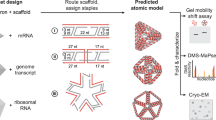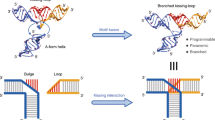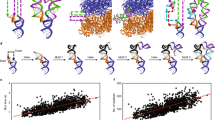Abstract
Synthetic nanostructures consisting of biomacromolecules such as nucleic acids have been constructed using bottom-up approaches1,2. In particular, Watson–Crick base pairing has been used to construct a variety of two- and three-dimensional DNA nanostructures3,4,5,6,7,8,9,10. Here, we show that RNA and the ribosomal protein L7Ae can form a nanostructure shaped like an equilateral triangle that consists of three proteins bound to an RNA scaffold. The construction of the complex relies on the proteins binding to kink-turn (K-turn) motifs in the RNA11,12,13, which allows the RNA to bend by ∼60° at three positions to form a triangle. Functional RNA–protein complexes constructed with this approach could have applications in nanomedicine14,15 and synthetic biology14,16,17,18.
This is a preview of subscription content, access via your institution
Access options
Subscribe to this journal
Receive 12 print issues and online access
$259.00 per year
only $21.58 per issue
Buy this article
- Purchase on Springer Link
- Instant access to full article PDF
Prices may be subject to local taxes which are calculated during checkout




Similar content being viewed by others
References
Seeman, N. C. Nanomaterials based on DNA. Annu. Rev. Biochem. 79, 65–87 (2010).
Lin, C., Liu, Y. & Yan, H. Designer DNA nanoarchitectures. Biochemistry 48, 1663–1674 (2009).
Goodman, R. P. et al. Rapid chiral assembly of rigid DNA building blocks for molecular nanofabrication. Science 310, 1661–1665 (2005).
Rothemund, P. W. Folding DNA to create nanoscale shapes and patterns. Nature 440, 297–302 (2006).
Andersen, E. S. et al. Self-assembly of a nanoscale DNA box with a controllable lid. Nature 459, 73–76 (2009).
Douglas, S. M. et al. Self-assembly of DNA into nanoscale three-dimensional shapes. Nature 459, 414–418 (2009).
Rinker, S., Ke, Y., Liu, Y., Chhabra, R. & Yan, H. Self-assembled DNA nanostructures for distance-dependent multivalent ligand–protein binding. Nature Nanotech. 3, 418–422 (2008).
Ke, Y., Lindsay, S., Chang, Y., Liu, Y. & Yan, H. Self-assembled water-soluble nucleic acid probe tiles for label-free RNA hybridization assays. Science 319, 180–183 (2008).
Voigt, N. V. et al. Single-molecule chemical reactions on DNA origami. Nature Nanotech. 5, 200–203 (2010).
Endo, M., Katsuda, Y., Hidaka, K. & Sugiyama, H. Regulation of DNA methylation using different tensions of double strands constructed in a defined DNA nanostructure. J. Am. Chem. Soc. 132, 1592–1597 (2010).
Moore, T., Zhang, Y., Fenley, M. O. & Li, H. Molecular basis of box C/D RNA–protein interactions; cocrystal structure of archaeal L7Ae and a box C/D RNA. Structure 12, 807–818 (2004).
Rozhdestvensky, T. S. et al. Binding of L7Ae protein to the K-turn of archaeal snoRNAs: a shared RNA binding motif for C/D and H/ACA box snoRNAs in Archaea. Nucleic Acids Res. 31, 869–877 (2003).
Turner, B., Melcher, S. E., Wilson, T. J., Norman, D. G. & Lilley, D. M. Induced fit of RNA on binding the L7Ae protein to the kink-turn motif. RNA 11, 1192–1200 (2005).
Guo, P. RNA nanotechnology: engineering, assembly and applications in detection, gene delivery and therapy. J. Nanosci. Nanotechnol. 5, 1964–1982 (2005).
Guo, P. The emerging field of RNA nanotechnology. Nature Nanotech. 5, 833–842 (2010).
Saito, H. & Inoue, T. Synthetic biology with RNA motifs. Int. J. Biochem. Cell Biol. 41, 398–404 (2009).
Saito, H. & Inoue, T. RNA and RNP as new molecular parts in synthetic biology. J. Biotechnol. 132, 1–7 (2007).
Win, M. N., Liang, J. C. & Smolke, C. D. Frameworks for programming biological function through RNA parts and devices. Chem. Biol. 16, 298–310 (2009).
Jaeger, L. & Chworos, A. The architectonics of programmable RNA and DNA nanostructures. Curr. Opin. Struct. Biol. 16, 531–543 (2006).
Leontis, N. B., Lescoute, A. & Westhof, E. The building blocks and motifs of RNA architecture. Curr. Opin. Struct. Biol. 16, 279–287 (2006).
Matsumura, S., Ikawa, Y. & Inoue, T. Biochemical characterization of the kink-turn RNA motif. Nucleic Acids Res. 31, 5544–5551 (2003).
Lescoute, A., Leontis, N. B., Massire, C. & Westhof, E. Recurrent structural RNA motifs, isostericity matrices and sequence alignments. Nucleic Acids Res. 33, 2395–2409 (2005).
Ikawa, Y., Tsuda, K., Matsumura, S. & Inoue, T. De novo synthesis and development of an RNA enzyme. Proc. Natl Acad. Sci. USA 101, 13750–13755 (2004).
Penchovsky, R. & Breaker, R. R. Computational design and experimental validation of oligonucleotide-sensing allosteric ribozymes. Nature Biotechnol. 23, 1424–1433 (2005).
Voytek, S. B. & Joyce, G. F. Niche partitioning in the coevolution of 2 distinct RNA enzymes. Proc. Natl Acad. Sci. USA 106, 7780–7785 (2009).
Horiya, S. et al. RNA LEGO: magnesium-dependent formation of specific RNA assemblies through kissing interactions. Chem. Biol. 10, 645–654 (2003).
Chworos, A. et al. Building programmable jigsaw puzzles with RNA. Science 306, 2068–2072 (2004).
Ko, S. H., Chen, Y., Shu, D., Guo, P. & Mao, C. Reversible switching of pRNA activity on the DNA packaging motor of bacteriophage phi29. J. Am. Chem. Soc. 130, 17684–17687 (2008).
Severcan, I. et al. A polyhedron made of tRNAs. Nature Chem. 2, 772–779 (2010).
Afonin, K. A. et al. In vitro assembly of cubic RNA-based scaffolds designed in silico. Nature Nanotech. 5, 676–682 (2010).
Saito, H. et al. Synthetic translational regulation by an L7Ae-kink-turn RNP switch. Nature Chem. Biol. 6, 71–78 (2010).
Goody, T. A., Melcher, S. E., Norman, D. G. & Lilley, D. M. The kink-turn motif in RNA is dimorphic, and metal ion-dependent. RNA 10, 254–264 (2004).
Service, R. F. Materials and biology. Nanotechnology takes aim at cancer. Science 310, 1132–1134 (2005).
Holler, N. et al. Two adjacent trimeric Fas ligands are required for Fas signaling and formation of a death-inducing signaling complex. Mol. Cell. Biol. 23, 1428–1440 (2003).
Ranzinger, J. et al. Nanoscale arrangement of apoptotic ligands reveals a demand for a minimal lateral distance for efficient death receptor activation. Nano Lett. 9, 4240–4245 (2009).
Ban, N., Nissen, P., Hansen, J., Moore, P. B. & Steitz, T. A. The complete atomic structure of the large ribosomal subunit at 2.4 Å resolution. Science 289, 905–920 (2000).
Acknowledgements
The authors thank R. Furushima, M. Sekiya and Y. Kodama (Japan Science and Technology Agency) for analysis and purification of Tri-RNPs, Y. Fujita (Kyoto University) and M. Takinoue (The University of Tokyo) for discussions, and A. Huttenhofer (Innsbruck Medical University) and T.S. Rozhdestvensky (University of Muenster) for providing the L7Ae plasmid. This work was supported by the JST International Cooperative Research Project. Part of the work was supported by the New Energy and Industrial Technology Development Organization (09A02021a).
Author information
Authors and Affiliations
Contributions
H.O., T.K., T.I. and H.S. designed the project. H.O., T.I., S.H.Y. and H.S. performed AFM. H.O., R.K. and K.E. performed RNP biochemical assays. H.O., S.H.Y., K.T., T.I. and H.S. evaluated the experimental results. H.O., T.I. and H.S. wrote the manuscript.
Corresponding authors
Ethics declarations
Competing interests
The authors declare no competing financial interests.
Supplementary information
Supplementary information
Supplementary information (PDF 3509 kb)
Rights and permissions
About this article
Cite this article
Ohno, H., Kobayashi, T., Kabata, R. et al. Synthetic RNA–protein complex shaped like an equilateral triangle. Nature Nanotech 6, 116–120 (2011). https://doi.org/10.1038/nnano.2010.268
Received:
Accepted:
Published:
Issue Date:
DOI: https://doi.org/10.1038/nnano.2010.268
This article is cited by
-
Branched kissing loops for the construction of diverse RNA homooligomeric nanostructures
Nature Chemistry (2020)
-
Use of human peripheral blood mononuclear cells to define immunological properties of nucleic acid nanoparticles
Nature Protocols (2020)
-
Controllable molecular motors engineered from myosin and RNA
Nature Nanotechnology (2018)
-
Protein-driven RNA nanostructured devices that function in vitro and control mammalian cell fate
Nature Communications (2017)



